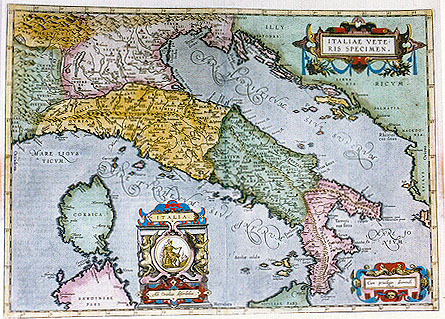Cartographica Neerlandica Background for Ortelius Map No. 204

Title: ITALIAE VETE:|RIS SPECIMEN. [Representation of Ancient Italy]. (Cartouche bottom right:) "Cum priuilegio decennali | 1584". [With a ten year privilege, 1584.] (cartouche bottom left centre:) ITALIA | "Ab. Ortelius describebat". [Italy, depicted by Abraham Ortelius].
Plate size: 350 x 491 mm.
Scale: 1 : 2,750,000
Identification number: Ort 204 (Koeman/Meurer:9P, Karrow: 1/155, vdKrogtAN: 7000H:31A).
Occurrence in Theatrum editions and page number:
1584L3Addblank (100 copies printed) (identical to 1584L, but here without page number; last line, left aligned: apud Pomponium & Antoninum nominantur.),
1584G3Add22 in upper right corner (75 copies printed) (last line, left aligned, in Gothic script like the entire text: Pompon.und Antonin.mit namen nennen.),
1584L104 (750 copies printed) (identical to 1584L3Add, but here with page number; last line, left aligned: apud Pomponium & Antoninum nominantur.),
1585F3Addblank (75 copies printed) (last line, left aligned: de delą le Po, LXXX. mille cheuaux,& DCC. mille pietons.),
1587F102 (250 copies printed) (last line, left aligned: de delą le Po, LXXX. mille cheuaux,& DCC. mille pietons.),
1592L9 or rarely 103 (500 copies printed) (last line, left aligned: nium & Antoninum nominantur.),
1595LK (500 copies printed) (last line, left aligned: alias quasdam,quę apud Pomponium & Antoninum nominantur.).
This map was replaced after 1595 by plate Ort 205, which does not have "ITALIA" in the lower left cartouche.
Approximate number of copies printed: 2250.
States: 204.1 as described.
204.2: in 1587, a number of region numbers were added all over the map, viz. Regio I, Regio II, Regio III, Regio IIII, Regio V, Regio VI, Regio VII, Regio VIII, Regio IX, Regio X, & Regio XI.
In the Giunti 1595L facsimile, two names have been added in manuscript in the Thyrrenian sea: P. Ferrarius and Giglio.
Cartographic sources: made by Ortelius, based on Gastaldi's map of Italy (Meurer p. 148-154, Karrow 30/90, p. 216-249), supplemented by classical sources, viz. Vergilius, Plinius, Ęlianus, Ęthicus, Strabo, Polybius and Varro.
For questions/comments concerning this page, please e-mail info@orteliusmaps.com.